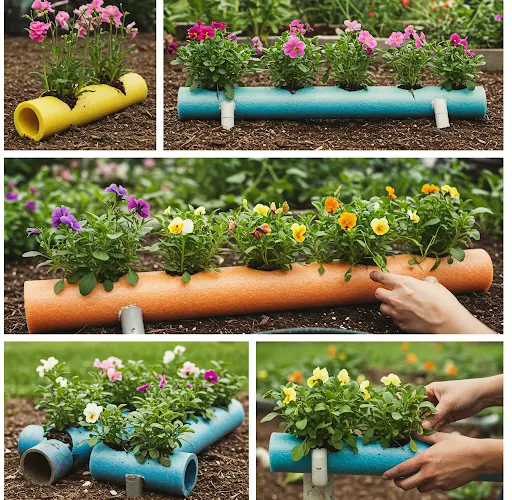Recycling PVC Pipes & Pool Noodles into Unique Planter Pots for Your Garden
Gardening enthusiasts are always looking for creative and sustainable ways to grow plants while reducing waste. One innovative and cost-effective method is repurposing old PVC pipes and pool noodles into unique planter pots. This DIY project not only promotes sustainability but also adds a creative touch to your garden. Whether you have a small balcony, backyard, or rooftop garden, using recycled materials is a fantastic way to grow plants while being eco-friendly.
Why Use PVC Pipes and Pool Noodles for Planters?
- Affordable & Readily Available – Many households have leftover PVC pipes or old pool noodles that can be upcycled.
- Durable & Weather-Resistant – PVC pipes are long-lasting and can withstand outdoor conditions.
- Lightweight & Portable – Unlike traditional clay pots, PVC planters are easy to move around.
- Customizable – You can design and paint them to match your garden aesthetic.
- Eco-Friendly – Reducing plastic waste helps protect the environment.
Materials You’ll Need
- PVC pipes (different diameters for variety)
- Pool noodles (standard foam type)
- Saw (to cut PVC pipes)
- Sharp knife or scissors (for cutting pool noodles)
- Drill (to make drainage holes)
- Sandpaper (to smooth rough edges)
- Acrylic paint or spray paint (for decoration)
- Paintbrushes
- Hot glue gun or waterproof adhesive
- Potting soil
- Seeds or seedlings (flowers, herbs, vegetables, etc.)
Step-by-Step Guide to Creating PVC & Pool Noodle Planters
Step 1: Cutting the PVC Pipes & Pool Noodles
- Measure & Mark – Decide on the height of your planters and mark where to cut the PVC pipes.
- Cut the Pipes – Using a saw, carefully cut the pipes into sections of varying sizes.
- Smooth the Edges – Use sandpaper to smooth out any rough edges to prevent injuries.
- Prepare the Pool Noodles – Cut the pool noodles into rings, which will act as decorative edges or inner liners for the planters.
Step 2: Making Drainage Holes
- Drill Holes at the Bottom – Drill small holes in the bottom of each PVC pipe section to allow proper drainage.
- Optional Side Holes – For vertical planters, drill side holes to create openings for planting multiple plants in one pipe.
Step 3: Decorating Your Planters
- Paint the PVC Pipes – Use acrylic or spray paint to add color to your planters. Let them dry completely before use.
- Decorate the Pool Noodles – Paint or wrap them with fabric for an added decorative touch.
- Assemble the Planters – Attach the pool noodle rings around the top edges of the PVC pipes using a hot glue gun or waterproof adhesive.
Step 4: Planting & Arranging Your DIY Planters
- Fill with Potting Soil – Choose high-quality soil suitable for the type of plants you want to grow.
- Plant Seeds or Seedlings – Select plants based on your climate and available space. Herbs, flowers, and small vegetables work well in these planters.
- Water Gently – Ensure the soil is moist but not waterlogged.
- Arrange Your Planters – Place them strategically around your garden, balcony, or vertical garden setup.
Creative Ways to Use PVC & Pool Noodle Planters
- Vertical Gardens – Stack multiple PVC pipe planters to create a vertical green wall.
- Hanging Planters – Drill holes and use ropes to hang the planters from railings or tree branches.
- Herb Gardens – Grow basil, mint, parsley, or other herbs for an easily accessible kitchen garden.
- Colorful Flower Displays – Mix and match painted planters for a vibrant garden arrangement.
- Outdoor Borders – Line up your DIY planters along pathways or fences for decorative edging.
Benefits of Using Recycled PVC & Pool Noodles for Gardening
- Reduces Waste – Repurposing old materials keeps plastic waste out of landfills.
- Saves Money – DIY planters are cheaper than store-bought alternatives.
- Encourages Creativity – Designing your own planters allows for unique garden setups.
- Easy Maintenance – PVC is low-maintenance and resists moisture damage.
Final Thoughts
Recycling PVC pipes and pool noodles into planter pots is a fun and sustainable way to enhance your garden. Not only does it give new life to old materials, but it also provides an innovative approach to gardening in small or urban spaces. Whether you want to grow flowers, herbs, or vegetables, this DIY project offers an affordable and eco-friendly solution. Start your recycling journey today and transform your garden with these creative planters!



